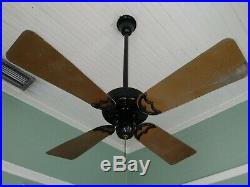
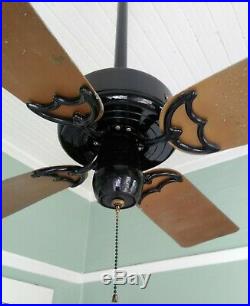
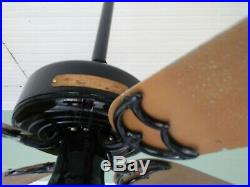

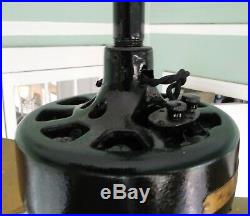
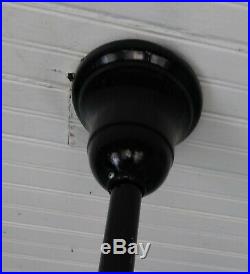
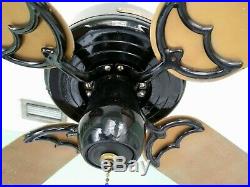
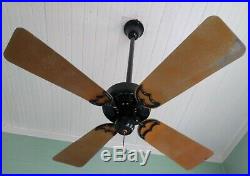

ANTIQUE 1920’S HUNTER TYPE 36 CEILING FAN / METAL BLADES -REFURBUSHED FULTON NY USA! BEAUTIFUL ANTIQUE HUNTER 36 CEILING FAN – THIS HAS BEEN RE-DONE. MADE HERE IN FULTON , NY. THE METAL BLADES ARE THE ORIGINAL FACTORY ANODIZED FINISH , JUST CLEANED UP AN PRESERVED AS MUCH AS POSSIBLE. THE ORIGINAL PORCELAIN PULLCHAIN SWITCH IS STILL IN THE FAN — HOWEVER , IT IS NOT CONNECTED , THE FAN IS DIRECTLY WIRED TO A VARIABLE SPEED WALL CONTROL (NOT INCLUDED). THIS WAS ORIGINALLY A ONE SPEED MODEL. THIS FAN RUNS DAILY AND BEAUTIFULLY! IT’S A POWERFUL LITTLE FAN! BLADES ARE PERFECTLY BALANCED – NO BENDS OR CREASES IN THE METAL. COMES WITH A HANGER BRACKET AND RUBBER GROMMET. DOWNROD IS NOT INCLUDED – ITS JUST STANDARD 3/4 PIPE – PAINTED. ALL SCREWS , PARTS ETC ARE INCLUDED. PERFECT FAN FOR A KITCHEN, BATH OR SMALLER BEDROOM! YOU CANT GET ANY BETTER THAN A HUNTER ANTIQUE CEILING FAN. SPEED CONTROLS FROM HOME DEPOT WILL NOT WORK FOR THIS. Feel free to contact Jacob with any questions eight one three 5 O 6 O 7 6 2. The Memphis-based company produces more than 300 residential, commercial, and industrial ceiling fan models under such names as the 1886 Limited Edition, the Hunter Original, the Seville, and the Fantasy Flier. Accounting for nearly one percent of the room air conditioner market, Hunter has manufacturing operations in Memphis as well as in Mexico and the Far East. The Hunter Fan Company was founded in 1886 in Syracuse, New York, by James C. Hunter and his father, John Hunter, immigrants from Ireland. Originally known as the Hunter Fan and Ventilating Company, the fledgling business first engaged in the manufacture of water motors and meters. The founders expanded their operations to include the production of belt-driven fans, the power for which was first provided by water motors and later by the Tuerk Electric Motor, which they developed. The Hunter reputation for quality was established early in the company’s history: some of these earliest belt-driven fans are still in use today after more than a century. In 1889 the growing company moved its operations to Fulton, New York, where it would spend the next fifty years at a plant located at Front Street, extending from Huling Street to Tolbot Street. Twelve years later, upon the death of John Hunter, his six sons incorporated the company and focused their attention on expanding the production of ceiling fans. By the early 1920s, the company was widely known for its high-quality electric fans. Noted for their elaborate “Dragon” design, the electric fans were best suited for ceilings from ten feet and up and were advertised as ready for electric lights. By the early 1920s the Hunter name was widely known throughout the United States and the world. The fans were especially popular in India and China, and throughout the Far East, where thousands were exported each year. By the mid-1920s, desk oscillating fans had been added to the Hunter product line. In 1936, after purchasing the fan division of Century Electric Company, Hunter began manufacturing large pedestal air circulating fans and direct exhaust fans as well, which were used by many of the finest hotels and stores. Two years later, the company began producing attic fans as well. With the onset of World War II, the company suspended the manufacturing of ventilating equipment for consumer use and concentrated its efforts on aiding the war effort, producing belt fans for government use in Army hospitals and barracks, and portable ventilators and oscillators for the Navy. With the postwar boom in the U. Economy, Hunter expanded its operations to keep up with the growing need for commercial and industrial ventilating equipment. In 1946 the company moved its plant from Fulton to its present location in Memphis in order to take advantage of the rapid industrial expansion of the South. Three years later, Hunter was acquired by Robbins & Meyers, Inc. For the next 45 years, Hunter operated as a wholly owned subsidiary of Robbins & Meyers, producing a complete line of residential, commercial, and industrial fans. Although Hunter performed consistently well throughout the 1960s and 1970s, by the mid-1980s the company’s limited line of ventilating products, combined with the entrance of a number of new competitors into the market, brought on financial crisis. Clouspy, who took over as company chairman and chief executive officer. During the two years following the takeover, the management team guided the company through the financial crisis, developing a strategy of product diversification that made Hunter profitable once again. Solidifying its financial base by refinancing its remaining debt, Hunter was now in position to expand its operations through acquisition. A designer and importer of residential lighting products. In June 1987, the company went public under the name Hunter-Melnor, Inc. The company’s renewed success was attributed in part to the management style of Clouspy and his colleagues, who opted for a highly decentralized team of four presidents, each responsible for one division of the company. As Hunter was expanding its operations during this period, the company again underwent an organizational change. In 1988, just a year after it had gone public, the company was privatized through a leveraged buyout led by the investment firm Leach McMicking. The transition, however, did not impede the turnaround of the company. Boosted by the strong performance of the Melnor group and its line of garden chemical products, the Hunter group was able to take advantage of the expanding fan market, landing four new major customers: Payless Cashways, Kmart, Wal-Mart, and Target. Fan sales, once limited primarily to the South, had extended throughout the nation. While Miami, for instance, represented Hunter’s top sales city in 1984, Phoenix headed the list in 1987, followed by Philadelphia and Chicago. Driven by these forces, fan sales jumped from 1.2 million units in 1980 to 16 million in 1987, the company’s one-hundredth year of operation. As Hunter-Melnor, led by president and chief executive officer G. Competing in a market driven by such volatile factors as the weather, new home construction, and remodeling, Hunter and the rest of the industry were especially vulnerable to the recessionary economy of the late 1980s and early 1990s. Nevertheless, Hunter continued its pattern of growth by focusing on the remodellingsegment of the industry, where the demand for its upscale units represented the greatest potential for profit. While these strategies kept Hunter-Melnor at the forefront of the industry, the company’s profitable Hunter division was weighted down by debt affecting the entire company. To alleviate this problem and make each division bear the responsibility for its own debt, Hunter-Melnor was divided into two corporations in September 1991. Under the reorganization plan, Robert Beasely took over as the new president and chief executive officer of Hunter Fan. Kenroy International was placed under its control as a subsidiary. Less encumbered by debt, Hunter Fan was able to direct its attention and resources to advertising and product development. While continuing to emphasize the home fashion aspect of its ceiling fans, adding such models as the Fantasy Flier–a fan replica derived from a naval archival drawing of an F4U fighter plane&mdashø its product line, Hunter Fan launched the largest advertising campaign in the history of the industry. The company set the stage for its aggressive strategy in the summer of 1992 by reformatting its logo across all of its product lines, incorporating a new Hunter green color and introducing upscale packaging graphics. Starting in May 1993, the company began advertising a wide variety of its ceiling fans in 30-second prime time television spots and in such popular magazines as Newsweek and Sports Illustrated, in which two-page, four-color spreads appeared. The unprecedented advertisements emphasized both the multipurpose dimension of ceiling fans, showing their effectiveness in areas as diverse as the bathroom and the porch, and the economical advantages of the product, making the case that fans are a cost-effective alternative to air conditioning. In the summer of 1993, the company introduced more than a hundred new lighting fixtures, including models featuring weathered metal, colored glass, and textured finishes, strengthening its reputation as the leading supplier of upscale decorative fans. In October of that same year, the company added another potentially profitable market to its repertoire when the United States Food and Drug Administration approved its air purifiers as Class II medical devices. Accordingly, the company launched a national print ad campaign targeting consumers with ads in magazines such as Ladies Home Journal, Reader’s Digest, and Modern Maturity. Perhaps the company’s most innovative and publicized campaign began in February 1995, seven months into a major league baseball strike. Going against conventional wisdom, Hunter Fan unveiled a baseball-themed ceiling fan and introduced a nationwide “Why I Love Baseball” program, calling for baseball fans to write letters explaining why they cherish the national pastime. As an added incentive to the fans, the company awarded trips to the Baseball Hall of Fame in Cooperstown, New York, and ceiling fans to winners of the contest, which was judged by such well-known baseball fans as filmmaker Ken Burns, Sporting News editor John Rawlings, and the “Clown Prince of Baseball, ” Max Patkin. Instead of proving a liability, the strike actually succeeded in generating widespread interest in the contest and in the novelty item. With more than 225 U. Radio stations and a host of television stations and major publications covering the campaign, Hunter Fan was able to reap benefits from what may have first appeared to be a marketing disaster: in just the first few weeks of the campaign, the baseball fan became one of the company’s leading sellers. Behind the strength of its bold marketing strategy, Hunter Fan has entered its second century of operation well positioned for continued expansion. How far past this level the company will go depends largely on the state of the U. Construction market, the success of new competitors to the industry, and the height of the mercury on the thermometer. Track Page Views With. Auctiva’s FREE Counter. The item “ANTIQUE 1920’S HUNTER TYPE 36 CEILING FAN / METAL BLADES -REFURBUSHED FULTON NY” is in sale since Sunday, March 17, 2019. This item is in the category “Home & Garden\Lamps, Lighting & Ceiling Fans\Ceiling Fans”. The seller is “jj-do-it-products” and is located in Tampa, Florida. This item can be shipped to United States, Canada, United Kingdom, Mexico, Germany, Japan, France, Australia, Denmark, Romania, Slovakia, Bulgaria, Czech republic, Finland, Hungary, Latvia, Lithuania, Malta, Estonia, Greece, Portugal, Cyprus, Slovenia, Sweden, South Korea, Taiwan, Thailand, Belgium, Hong Kong, Ireland, Netherlands, Poland, Spain, Italy, Austria, Bahamas, Israel, New Zealand, Philippines, Singapore, Switzerland, Norway, Saudi arabia, United arab emirates, Qatar, Kuwait, Bahrain, Croatia, Malaysia, Uruguay.
- EAN: Does not apply
- Model: 22309
- Material: Brass
- Fan Width: 52″
- Color: brass
- MPN: Does Not Apply
- Room: ANY
- Brand: Hunter



